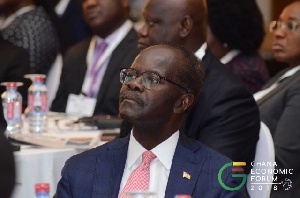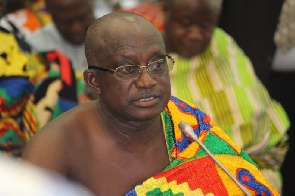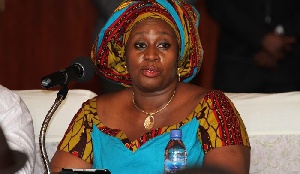The beginning is always a good place to start, HIPC. Heavily Indebted Poor Country. HIPC appeared to be the winning word as much as it was the word of contempt.
It was a solution to the problem of debt unsustainability. Ghana was one of the 37 countries to have benefited from the World Bank, International Monetary Fund, other multilateral, bilateral, and commercial creditors initiative of debt relief that began in 1996.
On July 3, 2001, during the discussion of the preliminary HIPC document, International Development Association made a preliminary determination that Ghana was eligible for assistance under the enhanced HIPC Initiative given its high level of indebtedness and external vulnerability.
The initiative’s Assessment and Action Plan ranked Ghana among the group of HIPC countries in Africa that required considerable upgrading of their public expenditure management capacity.
It is interesting to note that, the decades before the HIPC decision, Ghana’s GDP growth hadn’t been glorious. The average growth rates had been; 2.3% for the 1960s, 1.4% for the 70s, 2.0% for the 80s, and 4.3% for the 90s.
It is important to talk about GDP growth when we seek to answer whether or not Ghana’s borrowing and debt stocks are sustainable because the ratio of debt to GDP is one of the most important measures that show the extent to which an economy can withstand shocks emanating from its debt obligations.
So we can only answer the question of sustainable debt when it is analysed relative to GDP. GDP or Gross Domestic Product is the market value of all final goods and services produced in a country within a period (usually a year). It is used by economists as a measure of the performance of an economy and is the most widely used statistic in comparing the economies of different countries.
Having set the context, let us examine the facts that inspired this article; September 2020 Monetary Policy Committee’s press release, Paragraphs 10 and 11:
“On fiscal policy, provisional data on budget execution for the first seven months, showed an overall budget deficit of 7.4 percent of GDP, against the revised target of 7.2 percent of GDP as the COVID-19 pandemic continued to impact fiscal operations. The primary balance also recorded a deficit of 3.7 percent of GDP, above the planned target of 3.4 percent of GDP. Over the review period, total revenue and grants amounted to GH¢27.7 billion compared with the target of GH¢26.8 billion. Total expenditures and arrears clearance amounted to GH¢56.2 billion, above the target of GH¢53.3 billion.
These developments impacted the stock of public debt which rose to 68.3 percent of GDP (GH¢263 billion) at the end of July 2020, compared with 62.4 percent of GDP (GH¢218.2 billion) at the end of December 2019. Of the total debt stock, domestic debt was GH¢125.1 billion (32.5 percent of GDP) while external debt was GH¢138 billion (35.8 percent of GDP), representing 52.4 percent of the total public debt.”
The facts as they are presented by the Bank of Ghana without any further analysis gives considerable cause for concern, but before we dare to conclusions, let us ask some relevant questions. We may not agree on the answers considering elections are barely 40 days away but let us agree these are questions that need to be asked.
What does a debt to GDP of 68.3% mean in the spirit of a rebased economy? Measurements are agreeable social constructs, important ones at that. Measurements help us compare apples with apples and not oranges. On April 16th, 2018, the International Monetary Fund published its fifth and sixth review under the extended credit facility and had this to say “Based on updated macroeconomic projections, Ghana remains at high risk of external debt distress.
The assessment is reinforced by the elevated total public debt-to-GDP ratio, and four of five external debt indicators in breach of the thresholds under the baseline scenario.” The Debt Sustainability Analysis for Ghana reported a debt to GDP ratio of 73.8 percent for the year-end of 2016.
Agreeable debt to GDP limits appear to be 70%, anything beyond which, there is looming danger. But as basic mathematics will show, to reduce the measure of debt to GDP and appear debt sustainable, you have two options; reduce the numerator which is your debt stock, or increase the denominator which is the GDP, or perhaps both.
Although the average growth rates for the country since it became a republic till the turn of the millennia had not been too glorious, the average GDP for the first decade in the millennia was 5.4%, the highest performing decade in the history of the country. In 2010 however, something happened, a rebasing: which is determining the year by which all prices will be referenced to, the base year.
The base year used for Ghana’s GDP calculation was changed from 1993 to 2006 which caused the GDP growth for that year to increase significantly to 7.9% and subsequently 14% in 2011, the highest growth rate on record.
The average growth rate for the last decade has been 6.8%. The question however remains; how do we interpret Ghana’s debt sustainability considering we can change the base year which affects how small or big we view the economy? It is rather interesting to note that, for the second rebasing in less than a decade, changing the base from 2006 to 2013 caused the economy to grow by about a quarter more which means, we had increased our base for borrowing at least by about 20% more.
The significant debt stocks remained the same, which was a breach of acceptable limits, but we can add more because we have changed the year of referencing price in our GDP and appear a much bigger economy.
The worrisome conclusion of Ghana being “high risk of external debt distress” was given after the rebased figures, so does that mean rebasing does not reduce the risk of debt distress? Even more worrying is the fact that, after rebasing, the debt to GDP for 2016 which was 74% became just about 57% but clearly, it has increased to 68% which is about a 10% increase.
Does that mean if we assume the base to be 2006, Ghana’s debt will be completely unsustainable more than 80%? Let us also ask, does GDP mean wealth or revenue from which we pay the debt and is rebasing therefore not a cosmetic dressing of a scared unsustainable debt stock? Now imagine a bank has high Nonperforming loans, it can reduce the stock of nonperforming portfolio or just increase the total loan portfolio, and we know from some of the collapsed banks, this approach very similar in purpose with the rebasing may not be sustainable, but just maybe the magic will work for the nation.
Can we be sure if debt to GDP is 68.3% considering that the external debt of GH¢138 billion is subject to repricing daily? 63% of the entire debt stock is external and that is a big cause for concern because the trend of our currency since 1998 is purely exponential.
If the data is any true and the value in Ghana cedi will fall by half almost certainly every five years what does it mean for the country debt stock? Two implications are obvious, first, the external debt stock will increase by half at least every five years, accounting for only foreign exchange vulnerabilities.
The second implication is an additional average exchange rate cost of about 18% inherent in the annual price of the debt inclusive of the interest rate charge. The conversation about Reserve currencies and exchange rates is a very difficult and political one (international politics, I mean) for which reason holding external debt stock can sometimes only be a ticking bomb.
On the 11th April, 2020, the Economist published an article which had the quote, “The countries most at risk of default—and, by definition, the least able to borrow affordably—are those with limited domestic savings and large external debts, such as Angola, Ethiopia, Ghana and Zambia. But they are not the only ones in trouble.
Since 2010 average public debt in sub-Saharan Africa has risen faster than in any other developing region, from 40% to 59% of GDP in 2018. Most African countries have borrowed more than is prudent, said the IMF last year; 18 were classed as being in debt distress, or at high risk of it.”
The question yet remains, to what extent will the cedi depreciate in the next year, and to what extent will that depreciation drag the debt to GDP? There is no question about how vulnerable we all are to foreign exchange risk considering almost everything is imported. HIPC was decided on high levels of indebtedness but also high levels of external debt vulnerabilities. I dare ask, is HIPC creeping on us again?
What is the implication of these figures amidst a global pandemic? This is a rather difficult question of Ghana’s economic outlook considering the impact of the coronavirus. It will not be controversial to say, the outlook of Ghana’s economy does not look healthy following the global pandemic, as is many other countries.
The projections of productivity from which we get the denominator GDP is estimated to be about some of the lowest in recent history. This means that the denominated will get smaller again but the numerator will likely get bigger with more borrowing to stimulate the economy as well as possible exchange risks, it will therefore flow logically to see why an even higher debt to GDP figures for the country in the short to medium term is more likely. Does this present a risk of taking us back to the beginning, HIPC? Will we need another rebasing as cosmetic surgery? These are the hard questions we all must take a keen interest in finding solutions to.
These are conversations we must learn to depoliticize and solve as Ghanaians in the interest of posterity. The more worrying development is the increasing unemployment and yet the government’s need to increase revenue as a function of GDP in order to appear a credible middle-income country.
Will this mean more taxes considering the harsh economic reality looming? Are other conversations of debt reliefs the solution? It is also important to ask ourselves at this point that, what will be the projections of revenue to debt servicing, how much will we pay creditors from all the revenues we raise? These are the questions our aspiring leaders should be asked; the questions they should be actively planning to solve because the future demands a miracle.
There remain many more questions to be asked, questions about the implications of alternative debt arrangements such as Sinohydro’s US$2Billion in substance and not form when analyzing Ghana’s debt stock, questions about the foregone analysis’s effect on the purpose and status of the Fiscal Responsibility Act but let us find words to conclude, irrespective of the lurking questions, hopefully, to come again to you soon.
Debt is not always a bad thing. The measure of debt to GDP is even argued as a misleading measure considering the fact that Japan ranks as one of the countries with the highest debt to GDP at about 237% as at the end of December 2019 whiles Greece defaulted with ratios around 180% so the conversation should be nuanced a bit more.
Government borrowings are not always for good reasons and can be higher than socially optimal levels for political-economic reasons and that is the problem. It is a given fact that significant debt levels can negatively affect economic growth in the short to medium term. The effect of debt on growth would depend on the nature and structure of public debt.
Research has established a negative relationship between public debt and later economic growth but it is difficult to prove causality between the two measures. This is because the loans are used for different types of projects, have different terms and payment options, and different lenders.
There are also so many unobserved factors behind a country with low growth which could be causing both the low growth and debt accumulation, therefore, not all debts are the same since they have different effects on various aspects of an economy.
The average Ghanaian must however be awakened to this conversation as we find solutions together beyond traditional partisanship. We must find meaningful employment for our youth in our attempt to solve the declining GDP growth, we must transcend the narrative as the country that serves the world with raw materials as falling commodity prices and deteriorating terms of trade may not shift in favour of raw materials. We must also by all means stop considering debt rounds as success considering they are external debt stock at market rates.
Finally, there is no doubt about our developmental needs and infrastructure gaps that need financing, but we must seek and hopefully find the pathway to sustainable debt accumulation and increasing economic growth.
The question therefore should not be whether or not we are back to HIPC but how do we finance developmental projects sustainably. My name is Yaw Sompa, I believe in the ingenuity and resilience of the Ghanaian to find solutions through learning. I am a lawyer and an Enterprise Risk Professional.
- Commonwealth countries must create 5,000 jobs everyday till 2030 - Foreign Affairs Minister
- Use COVID-19 fund to strengthen health care, immunization financing — HFFG
- Parliament records a new case of coronavirus
- Breach of coronavirus safety protocols: GMA calls for action
- Chadians line up for Sinopharm as coronavirus vaccination campaign begins
- Read all related articles













